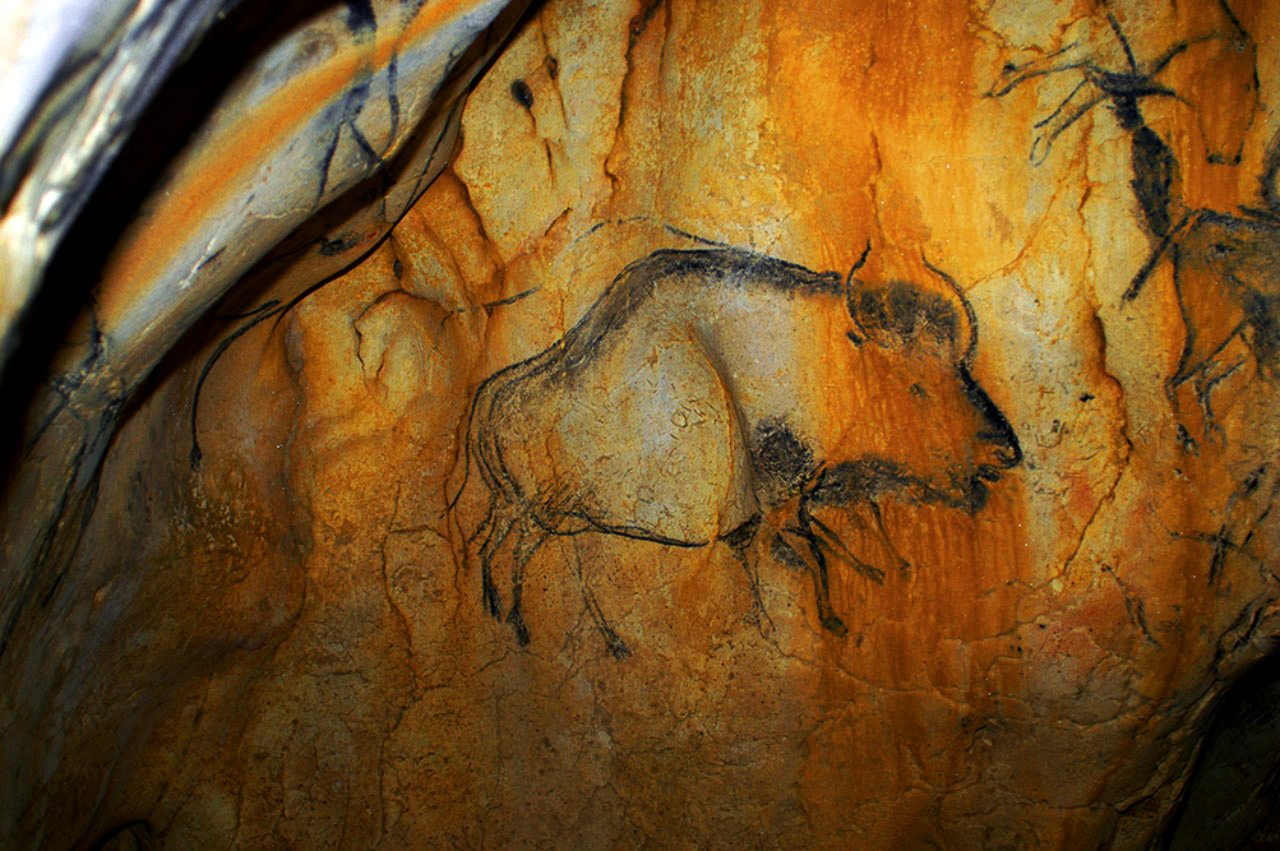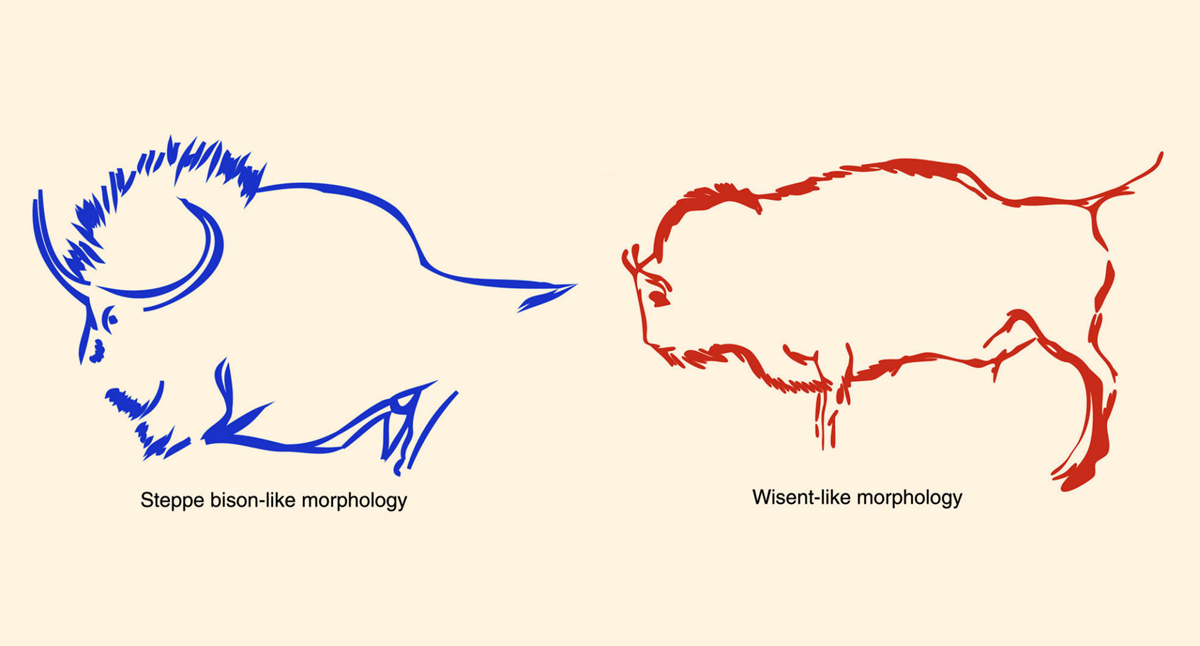


An article on sci-news.com - Higgs Bison: Mysterious Hybrid of Bison and Cattle Hidden in Ice Age Cave Art - reports on a recent study led by University of Adelaide researcher Julien Soubrier which reveals that prehistoric European cave artists recorded a previously unknown hybrid species of bison and cattle on cave walls more than 15,000 years ago.

Charcoal drawing of a steppe bison in Chauvet. Image: Carole Fritz.
This hybrid species originated over 120,000 years ago through the hybridization of the aurochs (Bos primigenius) - an extinct species of ox that inhabited Europe, Asia and North Africa - and the extinct steppe bison (Bison priscus). The hybrid species eventually became the ancestor of the extant European bison (Bison bonasus).
Co-author Prof. Alan Cooper, Director of the Australian Centre for Ancient DNA at the University of Adelaide, explained how rare such a hybridization event is in mammals.
"The genetic signals from the ancient bison bones were very odd, but we weren't quite sure a species really existed - so we referred to it as the Higgs Bison."
Ice Age Cave Art reveals hybrid Higgs Bison #Chauvet #Niaux https://t.co/H4ob1r5zp8 #RockArt pic.twitter.com/qdfplrrnEp
— Bradshaw Foundation (@BradshawFND) October 19, 2016
Charcoal drawings of bison in the Salon Noir chamber of the Niaux cave.
Genetic material extracted from radiocarbon-dated bison bones and teeth found in caves across Europe, the Urals, and the Caucasus was studied in order to trace the genetic history of the populations. A distinctive genetic signal emerged from many fossil bison bones, which was quite different from the European bison or any other known species.
Radiocarbon dating revealed that the hybrid species dominated the European record for thousands of years at several points, but alternated over time - as climate changed - with the steppe bison, which had previously been considered the only bison species present in Late Ice Age Europe.
Rock art experts in France agreed that there were indeed two distinct forms of bison art in Ice Age caves, and their ages match those of the different species. The cave paintings depict bison with either long horns and large forequarters ? more like the?American bison (Bison bison), which is descended from the steppe bison ? or with shorter horns and small humps, more similar to the European bison, also known as wisent.

Cave painting example of steppe bison-like and wisent-like morphs. Left: reproduction from Lascaux cave (France), from the Solutrean or early Magdalenian period (20,000 years ago). Right: reproduction from the Pergouset cave (France), from the Magdalenian period (17,000 years ago). Image: Julien Soubrier et al.
Once formed, the new hybrid species seems to have successfully carved out a niche on the landscape, and kept to itself genetically. It dominated during colder tundra-like periods, without warm summers, and was the largest European species to survive the megafaunal extinctions.
The research was published recently in the journal Nature Communications;
Early cave art and ancient DNA record the origin of European bison
Julien Soubrier, Graham Gower, Alan Cooper
Nature Communications 7, Article number:13158 (2016)
doi:10.1038/ncomms13158
Look at more rock art from the Chauvet cave:
http://www.bradshawfoundation.com/chauvet/index.php
Look at more rock art from the Niaux cave:
http://www.bradshawfoundation.com/niaux/index.php
by Bradshaw Foundation
Monday 30 May 2022
by Bradshaw Foundation
Wednesday 19 January 2022
by Bradshaw Foundation
Thursday 06 January 2022
by Bradshaw Foundation
Monday 06 December 2021
by Bradshaw Foundation
Monday 29 November 2021
by Bradshaw Foundation
Monday 25 October 2021
by Bradshaw Foundation
Monday 12 July 2021
by Bradshaw Foundation
Monday 24 May 2021
by Bradshaw Foundation
Tuesday 20 April 2021
by Bradshaw Foundation
Thursday 01 April 2021
by Bradshaw Foundation
Tuesday 23 February 2021
by Bradshaw Foundation
Thursday 14 January 2021
by Bradshaw Foundation
Friday 18 December 2020
by Bradshaw Foundation
Sunday 06 December 2020
by Bradshaw Foundation
Thursday 26 November 2020
by Bradshaw Foundation
Wednesday 07 October 2020
by Bradshaw Foundation
Monday 30 May 2022
by Bradshaw Foundation
Wednesday 19 January 2022
by Bradshaw Foundation
Thursday 06 January 2022
by Bradshaw Foundation
Monday 06 December 2021
by Bradshaw Foundation
Monday 29 November 2021
by Bradshaw Foundation
Monday 25 October 2021
by Bradshaw Foundation
Monday 12 July 2021
by Bradshaw Foundation
Monday 24 May 2021
by Bradshaw Foundation
Tuesday 20 April 2021
by Bradshaw Foundation
Thursday 01 April 2021
by Bradshaw Foundation
Tuesday 23 February 2021
by Bradshaw Foundation
Thursday 14 January 2021
by Bradshaw Foundation
Friday 18 December 2020
by Bradshaw Foundation
Sunday 06 December 2020
by Bradshaw Foundation
Thursday 26 November 2020
by Bradshaw Foundation
Wednesday 07 October 2020
Friend of the Foundation











